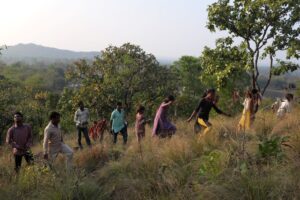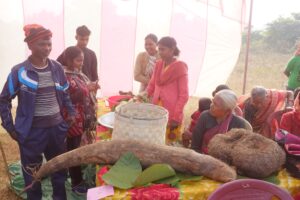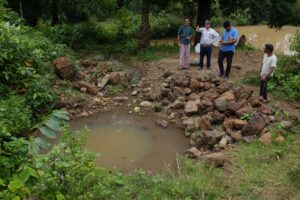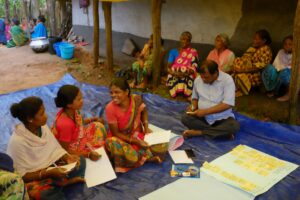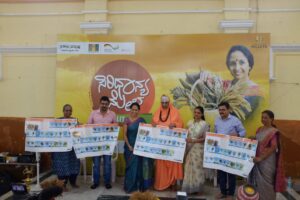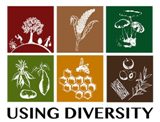Traditional Seeds and Wild food display and Seed Distribution at Ganeshpur – 31st May 2018
With the monsoons and the cultivation season fast approaching the UD fellows covering the Pahari Korwa project area – Jaykumar Yadav and Bhawru Hansda, decided to commence the distribution of traditional seeds from the community seed bank established at Ganeshpur to interested farmers in all project villages. In this regard an exhibition of the rich variety of traditional seeds that had been assimilated in the community seed bank was organised in Ganeshpur on the 31st of May 2018 which was followed by distribution of seeds to farmers for cultivation in their fields. The display also included a number of wild uncultivated foods from the Pahari Korwa villages of Raigarh district.
Ganeshpur village in Sisringa Panchayat, Dharamjaigad Block, Raigarh District is home to 50 households of which 32 are Pahari Kowars. The villagers of Ganeshpur largely depend on their surrounding forests and agriculture for their livelihood. They practice both traditional Bewra on forested hill slopes and mixed cropping in plain lands surrounding the village. The villagers reported that there has been a gradual decline in the practice of bewra and subsequently the availability and cultivation of several traditional crops, some of which have virtually disappeared from the area. The major cause for this decline in traditional agriculture and crops as attributed by the villagers was increased opposition of restrictions on carrying out of bewra by the Forest Department. Forest Department officials prohibit villagers from burning trees for bewra and this has resulted in increased conflict between the villagers and the Forest Department and a subsequent decline in the practice of Bewar. In this regard CFR titles as per FRA, 2006 would go a long way in helping villagers resolve their conflict with the FD especially with respect to bewra cultivation. The villagers revealed that while a CFR claim has been made and they have submitted the form and necessary supporting documents there has been no progress with respect to the processing of the claim and as the receipt of the submission has been lost the villagers are finding it hard to follow up the claim. Moreover, since there was a lack of clarity regarding CFR and the kinds of areas which can be included in CFR claims the CFR claim does not cover all the forest area that the villagers use and depend on.
The exhibition was attended by both men and women and the participants comprised representatives of all age groups with children, young men and women and village elders all coming together to view the rich diversity of seeds and wild food on display. The exhibition gave the villagers both young and old to come together to share their knowledge and experiences with the cultivation of the rich diversity of crops which was once found in the area. They discussed challenges faced in the cultivation of different crops and were excited to see and handle various seeds that had reduced significantly or disappeared from their area. Rawas and Khutra semi seeds cultivated by the Bhariyas of Patalkot in MP were also on display and they were the centre of attention as they are not found in this region and the farmers were excited to see and learn about them.
The farmers present were very keen to plant the seeds of a number of the different crops on display and they all mutually agreed to return double the amount of the seeds they took after harvesting in order to enable expansion of the community seed bank and to ensure more farmers can benefit from the initiative. After the exhibition and discussion was over 17 of the farmers present took a variety of different seeds for cultivation both in badi (plain) lands and bewra plots. The seeds distributed included – rahar, safed bede, safed jhunga, sutru, khutra semi, kang, madiam salhar, kala bede and sukda. All farmers’ names and the quantities of seeds they received were duly noted with villagers assisting the fellows in the distribution of seeds.
Traditional Seeds and Wild food display and Seed Distribution at Amanara–1st June 2018
 Seed distribution at Ganeshpur on 31st May 2018 was followed up by a similar program at Amanara village on the 1st June 2018. Amanara which is also home to UD fellow Bhawru Hansda comprises 53 households of which 50 are Pahari Korwa. The villagers’ livelihoods are largely dependent on agriculture – bewra, mixed cropping in badi (plain) lands, and mono-cropping; and the collection of a variety of forest produce both for consumption and sale in local markets. The distribution of seeds in Amanara was preceded by a display of traditional seeds and wild food and a discussion on matters pertaining to traditional agriculture, forests and forest rights. The program was attended by a wide cross section of villagers – men, women, youngsters, and seasoned farmers. Those present took turns in identifying the different seeds and wild foods on display. The youngsters started and were able to correctly identify a number of different seeds and wild foods. The older farmers then filled in the gaps and helped identify the remaining items.
Seed distribution at Ganeshpur on 31st May 2018 was followed up by a similar program at Amanara village on the 1st June 2018. Amanara which is also home to UD fellow Bhawru Hansda comprises 53 households of which 50 are Pahari Korwa. The villagers’ livelihoods are largely dependent on agriculture – bewra, mixed cropping in badi (plain) lands, and mono-cropping; and the collection of a variety of forest produce both for consumption and sale in local markets. The distribution of seeds in Amanara was preceded by a display of traditional seeds and wild food and a discussion on matters pertaining to traditional agriculture, forests and forest rights. The program was attended by a wide cross section of villagers – men, women, youngsters, and seasoned farmers. Those present took turns in identifying the different seeds and wild foods on display. The youngsters started and were able to correctly identify a number of different seeds and wild foods. The older farmers then filled in the gaps and helped identify the remaining items.
The villagers pointed out that bewra cultivation is still actively practiced by village households though potential conflict with the forest department looms in the background. Which most villagers have submitted and received IFR titles there has been no CFR claim made. While a FRC (Forest Rights Committee/ Van Adhikar Samiti) is in place there is little awareness about its functioning and its role with regards to CFR claims. The households of Amanara depend on a large area of forest for their livelihoods and CFR title over this forest would go a long way in securing tenure and mitigating conflict with the Forest Department and other agencies.
21 men and women farmers collected different varieties of seeds for cultivation in bewra and badi lands with a resolution of returning double of what they have taken after harvesting in order to help increases the stocks of the community seed bank and reach out to more farmers of the region.
Wild Food collection and Bewra cultivation – 2nd June 2018
 On the morning of 2nd June 2018, we accompanied Tiharu Murihar, Ratlo Hansda, Bhuneshwari Hansda, Buth Kunwer Murihar, Ratiaso Murihar and Sanihari Ginu on a trail through Meng Dahi forest for wild food cultivation and sowing and burning in bewra plots.
On the morning of 2nd June 2018, we accompanied Tiharu Murihar, Ratlo Hansda, Bhuneshwari Hansda, Buth Kunwer Murihar, Ratiaso Murihar and Sanihari Ginu on a trail through Meng Dahi forest for wild food cultivation and sowing and burning in bewra plots.
The wild food collected included –
· Saroti Bhaji – a wild leafy vegetable which is available 11 months of the year (the tree sheds its leaves in May).

· Koinjhari Bhaji – a small plant which is eaten whole and is found primarily in the forests of Ganeshpur and Amanara in June and July. It does not occur in forests of other project villages.
· Nakwa Kanda – the tuber of a climber which is found in medium and open forest areas. Nakwa kanda is used as a cure for cough.
· Dindori Kanda – the tuber of a climber which also has medicinal properties.
· Semer Kanda – the tuber of a tree which is extracted when the plant is young. This tuber is eaten raw and is a valuable source of sustenance during visits to the forest.
· Samarladi Kanda – is the tuber of a small plant which is use as a fermenting agent in making hadia (rice liquor).
 The villagers also sowed seeds in Tiharu Murihar’s bewar plot. While Tiharu and Bhawaru scattered seeds over the plot, the women used khunti’s to make small holes in which they sowed their seeds. The seeds sowed included bede, kang, madia, sikher, sukhda, rahar and khira. On the way back to Amanara they burnt the dried vegetation in Mangahu Murihar’s bewra plot in preparation for sowing.
The villagers also sowed seeds in Tiharu Murihar’s bewar plot. While Tiharu and Bhawaru scattered seeds over the plot, the women used khunti’s to make small holes in which they sowed their seeds. The seeds sowed included bede, kang, madia, sikher, sukhda, rahar and khira. On the way back to Amanara they burnt the dried vegetation in Mangahu Murihar’s bewra plot in preparation for sowing.
In the evening Bhawru collected 3-4 kg of Gath Kanda from the open forest areas fringing Amanaras agricultural land. Gath kanda is a bulbous hairy tuber of a climber found mostly in forest fringes, open and medium canopy forest areas. The preparation process for this tuber is long and labour intensive. After returning home Bhawru along with his family members and neighbours pealed the tubers and cut them into thin round slices which were then boiled. After boiling the tuber slices were tied in a cloth and left in the river over night from which they were collected before dawn the next day and boiled once more. Men, women and children then gathered to jointly consume the tuber. This is a customary practice and neighbouring households’ help in processing the tuber and then villagers of all ages get together to consume the processed Gath kanda. While consumption of gath kanda was widespread in the past, due to the labour intensive processing involved it’s consumption has reduced though the villagers still relish it on the occasions that someone collects and prepares it. Gath kanda is extremely bitter when raw and the long processing removes the bitterness. It helps ward away malaria and other diseases and is very high in protein.
 Learnings from the Field Visit
Learnings from the Field Visit
· Traditional Bewra cultivation on forested hill slopes and mixed cropping on badi (plain) lands is still practiced by villagers of Ganeshpur and Amanara though they are slowly on the decline.
· Mixed cropping on Badi lands is being replaced by mono-cropping of the different seeds.
· The major threat to Bewra is the increased prohibition on its practice by the Forest Department which has resulted in a decline in Bewara and subsequent decline in cultivation of a number of traditional crops, several of which have disappeared from the area.
· The forests in this area are still rich and dense with minimal sign of degradation. The villagers reported that there has not been a decline in availability of all major forest produce Except for bamboo.
· Traditional crops and wild food still comprise a substantial part of the villagers’ diet with minimal dependence on the market and PDS rations. These sources of food make an invaluable contribution to the health and nutrition of the villagers. The villagers also make valuable additional income from the sale of forest food like keonjhari bhaji.
· The quality of the forests and their tremendous contribution to the livelihood, food and health security of the Pahri Korwas makes it essential to secure their tenure and put in place community based management and protection systems. The villagers reported that there was considerable exploitation of various forest produce by outsiders for commercial gain.
· While most villagers have received IFR titles there is an urgent need for increased awareness about CFR and processes involved including roles and responsibilities of FRC (Forest Rights Committee). The villagers of Ganeshpur and Amanara should be provided awareness and capacity building to effectively compile and submit CFR claims along with all necessary supporting documents. They also need support in following up of claims to ensure timely processing.
· The consumption of wild food whose collection and processing are more labour intensive are declining.
· There is a need for continued intensive research and documentation of traditional agriculture and crops, and forest produce collection, consumption and sale along with current trends, changes in consumption patterns and driving factors. This should be then uses to design and conduct awareness programs on benefits of traditional agriculture, crops and wild food and the need to protect and revive them.


